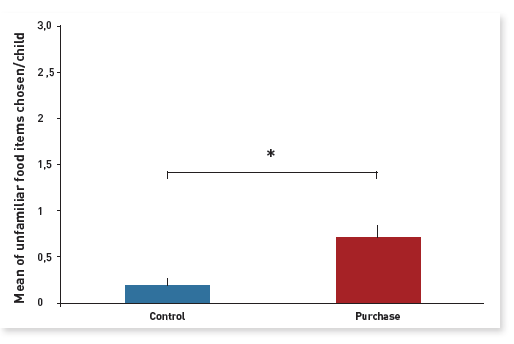Involving children in the purchasing of food: a strategy aimed at reducing food neophobia
In the context of the high prevalence of childhood obesity, it is crucial to promote a balanced diet, rich in fruit and vegetables (F&V). One of the strategies used to stimulate the consumption of vegetables in children is to reduce their food neophobia (i.e. their reluctance to try new food), which is associated with a poorer diet and a reduced consumption of F&V.
Increasing familiarity with vegetables to improve their acceptability
Promoting exposure to new food to increase familiarity and create positive experiences with new foods is a strategy which has proven effective in reducing food neophobia in children.
Sensory education, for example, has shown its effectiveness in this regard. While involving children in the different meal preparation stages is another way to increase familiarity and create positive experiences, there is limited research on its effect on neophobia.
Cross-sectional studies have highlighted a positive association between involvement in meal preparation and healthy eating habits1. Some interventional studies including cooking or gardening activities have also shown promising results2. A recent experimental study3 carried out by our team revealed an increase in the willingness to try new food following a cooking session involving this food.
The objective of the present study was to assess the effect of involving children in the purchasing of food on their willingness to try unfamiliar foods and their food choices.
Participating in the purchase of food: what are the effects on choices?
Eighty six children aged 8 to 10 were invited to participate in a food workshop, followed by an afternoon snack. Half of these children (Purchase group) took part in the online purchasing of the ingredients required to prepare 3 unfamiliar dishes containing vegetables: an apple/beetroot juice, a zucchini omelette and a spinach biscuit. The other half of the participants (Control group) took part in a creativity workshop instead. Upon completion of the workshop, the children in both groups were invited to make 3 food choices for their snack, between familiar and unfamiliar foods:
[1] orange juice vs apple/beetroot juice,
[2] potato omelette vs courgette zucchini and [3] chocolate biscuit vs spinach biscuit.
The average number of unfamiliar foods spontaneously selected for a snack was significantly higher in the Purchase group (0.70 ± 0.14) than in the Control group (0.19 ± 0.07) (see Figure 1).

Figure 1: Mean number of unfamiliar foods selected by children for their snack in the Control group in blue (n = 43) and the Purchase group in red (n = 43).
In a previous study3, the “purchasing” workshop was replaced with a “cooking” workshop during which the children cooked the 3 new dishes themselves. The comparison of the results of both studies shows a similar effect of children’s involvement in purchasing ingredients (0.70 ± 0.14 unfamiliar foods selected) and cooking dishes (0.74 ± 0.13 unfamiliar foods selected).
Involving children in all stages: a simple and effective strategy to stimulate the willingness to try
This study demonstrates that involving children in food purchasing as well as cooking can be an effective strategy to guide their choices towards unfamiliar foods containing vegetables. These results were recently confirmed in a school context4 and over a longer period, justifying the pertinence of interventions aimed at involving children in the choice of dishes, the purchasing of ingredients and cooking, to facilitate the integration of new vegetable-based dishes into school canteens.
Based on: Allirot X, Maiz E, Urdaneta E. Shopping for food with children: A strategy for directing their choices toward novel foods containing vegetables. Appetite.
2018 Jan 1;120:287-296.
References
- Chu YL, Storey KE, Veugelers PJ. Involvement in meal preparation at home is associated with better diet quality among Canadian children. J Nutr Educ Behav. 2014;46(4):304-308.
- Hersch D, Perdue L, Ambroz T, et al. The impact of cooking classes on food-related preferences, attitudes, and behaviors of school-aged children: A systematic review of the evidence, 2003-2014. Prev Chronic Dis. 2014;11:E193.
- Allirot X, da Quinta N, Chokupermal K, et al. Involving children in cooking activities: A potential strategy for directing food choices toward novel foods containing vegetables. Appetite. 2016;103:275-285.
- Allirot X, Maiz E, Urdaneta E. Du choix de la recette à la préparation en cuisine : résultats d’une étude d’intervention en milieu scolaire pour améliorer les choix alimentaires des enfants. Poster présenté aux Journées Francophones de Nutrition 2017 (Nantes).
